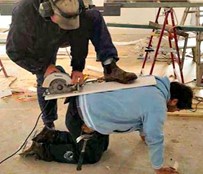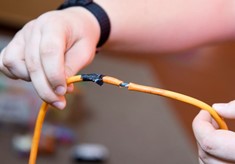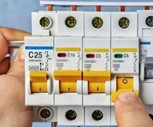Week 3
| Day One | Day Two | Day Three | Day Four | |
|---|---|---|---|---|
| Course Content | Safeguards for power tool use – tool safety, operating technique, cord safety, etc. | FIRST AID Course External Provider | FIRST AID Course External Provider | Electrical Faults – open circuit, short circuit, ground fault, overloads, sags and surges. Control methods - preventative, diagnostics & correction. |
| Self-directed Learning | Watch CITBSA videos on tool safety. | Review information from First Aid training | Review information from First Aid training | Watch video and summarise the measures taken to mitigate faults. |
In order for you to gain the most value from your qualification and to prepare you for your assessment and the industry, make sure you complete all of the SDL tasks.

What we're covering:
- Safeguards for power tool use – tool safety, operating technique, cord safety, etc.
To ensure safety while using power tools, it is essential to follow safety guidelines, wear appropriate PPE, and undergo proper training on tool usage and maintenance. Regular inspections and a clean, organised workspace can also help minimise hazards and potential risks. Standards and best practices for using power tools are discussed below:
Tool Safety
The basic rules for using electrical tools safely include:
- Use the right tool for the job.
- Inspect each tool for damage before use. Never use a damaged tool - take damaged tools out of service immediately.
- Keep all tools in good condition with regular maintenance.
- Operate tools according to the manufacturer’s instructions.
- Wear the proper PPE.
- Do not remove or alter safety guards on an electrical tool.
- Disconnect power tools from the power source when not in use to prevent accidental activation.
- Keep power tools and cords away from water, liquids, and wet surfaces to avoid the risk of electrical shock.
- For power tools that require grounding, make sure they are connected to properly grounded outlets to prevent electrical shock.
Opt for power tools with double insulation – these tools offer an additional layer of safeguard against electric shock, particularly beneficial in cases of external insulation damage. To check if a tool is double insulated, look for the words "Double Insulated" or a double square symbol, which means it's designed with this added safety feature.
NEVER DO THIS!!!

Operating Technique
Be sure to keep good footing and maintain good balance when operating power tools. Avoid accidental starting. Do not hold fingers on the switch button while carrying a plugged-in tool. Always keep your hands firmly on the handles of the tools.
Wear proper PPE for the task and avoid loose clothing, jewelry, etc., that can become caught in moving parts.
Cord Safety
When it comes to using power tools, electrical cord safety is a vital consideration and it's important to adhere to proper safety practices:
Keep cords away from heat sources, liquids, and sharp edges to prevent potential hazards.

Check cords and plugs regularly for any signs of damage, fraying, or exposed wires. Do not use tools with damaged cords or plugs. Secure cords in place using cable ties or clips to prevent tripping hazards. When using extension cords, ensure they match the power requirements of the tool in use.
De-Energise Equipment
Before performing maintenance or changing accessories on power tools, you must disconnect them from the power source to prevent accidental activation.
Avoid Overloading Circuits
Do not overload electrical circuits by connecting too many tools to a single outlet. Overloading can lead to overheating, fires, or tripped circuit breakers. Also ensure the power tool matches the electrical system's voltage and frequency to avoid overload.

Use RCDs
Residual Current Devices cut off power if any current leakage is detected, ensuring a safer working environment. They provide an extra layer of protection against electric shock. Use portable RCDs for power tools if necessary. Ensure they are properly installed and regularly checked for functionality.
Work Area Organization
Adequate lighting, ergonomic workstations, and good housekeeping help to ensure power tool safety. Ensure the work area is well-lit and organised. Clear away clutter and debris that could cause tripping hazards or obstruct the use of power tools. Keep everyone not involved in the work at a safe distance from the work area.
Lockout/Tagout
When performing maintenance or repairs on electrical equipment, use lockout/tagout procedures to isolate the equipment from the power source to prevent accidental start-up.
Training and Education
Ensure that all individuals using power tools receive proper training on electrical safety, including recognizing hazards and using appropriate PPE. Workers should be trained in the proper use of all electrical tools they may be required to use.
Test and Tag
Electrical equipment on building sites must be tested and tagged every 3 months. See standard AS/NZS 3012:2019 Electrical installations - Construction and demolition sites. The tag should give the date of the inspection and the next date an inspection is due.
Circuit Breakers
Install circuit breakers to prevent circuit overloads and protect the power tool from electrical surges.

Emergency Stop System
The power switch installed in most power tools is not easy to reach in emergency situations. Employers should, therefore, implement an emergency stop system.
Risk assessments
Providing routine risk assessments of the workplace can help employers reduce power tool-related accidents and injuries.
Environmental Factors
- Do not use power tools in damp or wet locations unless they are approved for that purpose.
- Use equipment suitable for the working environment, e.g., cordless tools for damp conditions.
- All electrical connections for electrical tools must be suitable for the type of tool and the working conditions (wet, dusty, flammable vapors).
- If a portable electrical appliance is used in damp situations, it must have the following safeguards:
- An isolating transformer with a voltage between conductors not exceeding 230 volts.
- Double insulation to the appliance.
- A source to earth connection so that the earth voltage does not exceed 55 volts.
- An RCD to monitor the electric current flowing through the circuit. (If you touch a live wire or faulty equipment and electricity flows through you to the ground, the RCD senses the reduction in current and shuts off the electricity. This reduces the risk of a serious or fatal injury.)
Exercise 12
You're tasked with using an angle grinder for electrical installation work. Complete the table in this worksheet by adding your own descriptions of the safety measures that you should implement to ensure your safety and proper use of the angle grinder.
Self-directed Learning
Watch this series of CITBSA videos on tool safety to confirm you are now well-informed on working safely with both hand and power tools.

What we're covering:
- FIRST AID Course review
A two-day first aid course, which your tutor will organise for you, is a part of the learning for this programme. In this session and the next you will find some tools for you to review the learning from the course or prepare for if you have not yet attended it.
Go to the Hato Hone St Johns New Zealand website here. The link will take you to the First Aid Library page. There is useful information about a range of emergencies that require first aid treatment.
Task
Write a quiz for your classmates, using the information from the First Aid Library. You can use Google Forms or Microsoft Forms (both free) to make your quiz. Put the link in the class forum for other people to try.
What we're covering:
- FIRST AID Course review
This lesson continues reviewing your knowledge around workplace first aid. Head back to the Hato Hone St Johns New Zealand website and try their ready-made quiz here.

What we're covering:
- Electrical Faults – open circuit, short circuit, ground fault, overloads, sags and surges.
- Control methods - preventative, diagnostics & correction.
What is an electric fault?
An electrical fault is an abnormal condition in a power system or equipment. It happens when the current flowing through a circuit is partially or completely interrupted.
Faults can occur for various reasons, including equipment failure, environmental conditions, and human error. Some common causes of faults include faulty wiring, damaged insulation, overloaded circuits, lightning strikes, power surges, and voltage fluctuations.
The signs of a fault can vary depending on the type of fault and the location of the fault. However, some common indications of an electrical fault include flickering lights, circuit breakers tripping frequently, burning smells, and overheating equipment.
Detecting and understanding the symptoms and causes of electrical faults is essential for maintaining the reliability of systems, reducing downtime, and ensuring the safety of both equipment and individuals.
You can prevent faults from occurring by following proper safety practices, which includes regular maintenance and inspection of equipment, using the correct type and size of electrical components, and avoiding overloading circuits. It is also essential to safeguard power systems by using protective devices like circuit breakers and relays.
Types of electrical faults
The most common types of faults include open circuit faults, short circuit faults, and ground faults.
Open Circuits
An open circuit fault happens when the path that electricity follows is broken or interrupted. This can occur due to damaged wires, blown fuses, or disconnected parts of the circuit. When this situation arises, the flow of electricity is halted, causing devices or systems connected to that circuit to stop working. This interruption can result in the failure of devices or systems dependent on that circuit.
| Symptoms | Causes |
|---|---|
|
|
Short Circuits
A short circuit fault occurs when two conductors with different electrical potentials directly touch, creating a pathway with very low resistance for the current to flow through. (Usually when a "Live" wire touches a "Neutral" wire or an "Earth" wire.) This situation leads to an overflow of current, which can have severe consequences such as fires or damage to equipment. In simpler terms, it's like two wires that shouldn't touch suddenly coming into contact and causing a rush of electricity.
| Symptoms | Causes |
|---|---|
|
|
Ground Faults
A ground fault happens when an unintended connection between a live conductor and ground occurs, often due to insulation breakdown. This can lead to safety hazards, such as electric shocks.
| Symptoms | Causes |
|---|---|
|
|
Overloads
Overloads occur when a circuit is subjected to a higher current than it can handle, often due to excessive load or faulty devices. This can lead to overheating, component damage, power outages and fire hazards.
| Symptoms | Causes |
|---|---|
|
|
Voltage Sags and Surges
Voltage sags (dips) and surges (spikes) are temporary deviations from the standard voltage level. Sags can lead to equipment malfunctions, while surges can cause immediate damage.
| Symptoms | Causes |
|---|---|
|
|
Harmonics
Harmonics are non-standard frequencies that can distort the sinusoidal waveform of alternating current. These can result from nonlinear loads and cause overheating in devices.
| Symptoms | Causes |
|---|---|
|
|
Control methods

Electrical issues are common, but we can reduce their impact by preventing, detecting, and fixing them promptly in order to avoid greater damage to equipment and personnel:
Preventive Measures
- Regular inspections and maintenance to identify and rectify potential faults before they cause disruptions.
- Proper training for personnel to ensure correct wiring and installation practices.
- Using high-quality materials and components to minimise the risk of faults.
Diagnostic Techniques
- Infrared thermography to identify hotspots caused by excessive resistance.
- Megohmmeter testing to assess insulation resistance.
- Current and voltage analysis to detect imbalances.
Fault Correction
- Isolation and repair of faulty components or connections.
- Replacement of damaged cables or insulation.
- Ensuring proper grounding and bonding.
Strategies for specific faults
Overloads and Short Circuits
- Install appropriate circuit protection devices (fuses, circuit breakers and protective relays).
- Design systems with safety margins to handle transient overloads.
- Balance loads across phases.
Voltage Sags and Surges
- Implement voltage regulation devices.
- Install surge protection devices (SPDs) and lightning protectors.
- Consider uninterruptible power supply (UPS) systems for critical equipment.
Harmonics
- Use harmonic filters to mitigate distortion.
- Avoid excessive use of nonlinear loads.
- Balance phase loads and improve power factor.
Exercise 13
Email your solutions to the following issues to your tutor.
- You're in a workshop, and the lights suddenly flicker when a large machine starts. Explain why this happens and suggest a simple way to prevent it.
- Your computer shuts down unexpectedly during a thunderstorm. Why might this happen, and what basic measure could you take to safeguard your computer?
- A hair dryer suddenly stops working. Describe a step-by-step approach to determine whether it's an open circuit or a short circuit fault causing the issue.
- Explain how using too many devices on the same power strip can lead to a safety hazard and suggest an alternative arrangement.
- A kitchen appliance experiences a ground fault. What danger does this pose, and how can you protect yourself from such a hazard?
Self-directed Learning
Watch this video where the apprentice Reuben is tasked with finding five electrical faults.
Make your own notes about the faults and the way each is mitigated. Discuss on the class forum.
